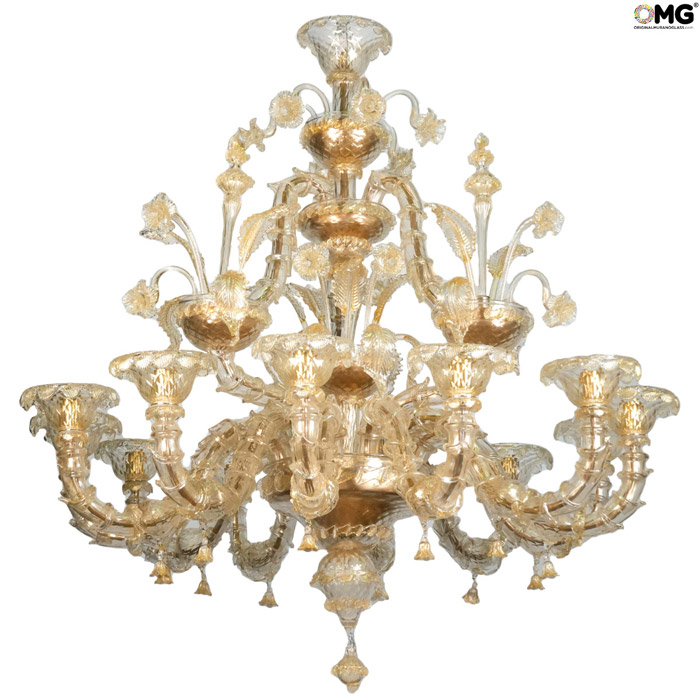If for some reasons – a joke or an imaginary question- we must point at an element of the Murano’s production which alone is able to represent all the vary quality of this old and noble tradition, the one which would sound as would be surely the venetian chandelier
Multiform, luxury and complex, the chandelier may have many features and shapes: from a majestic floral explosion to a pleasant and abstract lightness; from a vivid flow of the rainbow to a minimal design shaped by more tenuous shades. Anytime, still being able to donate the century-old spell, that is this technique, to the observer.
Telling the chandelier…from the dawn
The chandelier as furniture object fulfills since the oldest ages the practical role of lighting the spaces and the esthetic role of enhancing the aspect of the room in which is put. In the ages of the ancient Roman and Christianity, there are three main types of chandelier; those differ upon the technique and the flame’s alimentation: thecanthara were alimented trough oil, thephara through candles and the phara were fusion of the prior two.
Throughout the centuries, the improvement of the production of materials and the creative experimentation have taken the lighting structures to build tied with the Murano glass already in XIV century, as proved by the reference to the cesendello (that is, a type of lamp lengthened which was very fashionable around the Middle Ages) founded in a Paduan document of 1374. 
Giuseppe Briati and the Rezzonico chandelier
With the coming of the Murano’s chandelier, venetian chandelier, we found the quality step up, at least as long as the richness of the aesthetic offer and the complexity of the production are concerned. Noble father and undiscussed master of this fundamental piece of glass tradition is – without doubts – Giuseppe Briati, who was able since ‘700 to raise the prestige of the Murano art again. Art which collapsed by the end of XVII under the competition of the Bohemian and English crystal.
He was responsible the creation of a crystal close to the bohemian one for the brightness, but more suitable to the hot working, and consequently the production of vary chandeliers which can count on the possibility of havingbigger dimension and aesthetic experimentations and shapes prior unimaginable
A timeless classic: the Rezzonico chandelier
The Rezzonico chandelier (primary made during ‘700) can be considered as the prince of the illumination sector. It was made for the homonym family, who lived in the luxury Ca’ Rezzonico on the Grand Canal, nowadays the Venetian eighteen-century museum. This type can have many variation: with 5, 6, 8, 9, 10, 21, 36 or more lights, even until 60 as the great chandelier of the Murano Glass Museum, high 398cm, 226cm of maximum diameter and weight 330kg.
The chromatic combinations can be roughly unlimited: the classical style reckon on articulate forms of floral sort with branches, fronds, leaves and flowers which cross in magnificent curls, a harmonic whole in which over the metal structure can be placed hundreds of glass pieces, blown and handmade. Another aesthetic solution from the eighteen-century tradition is the so-called “ciocca alla Chinese”, the introduction of oriental motifs which remember the form of a pagoda.
The typical elements of the Rezzonico, quantifiable also in more than 500 handmade-pieces, are placed on the metal structure in order to cover it completely, following a procedure called investitura
The concave section, placed in the lower handle of the arms is called tazza orcoppa: its old function was to save the wax of the candles, while nowadays with the electric illumination it is used to cure the light refraction shades. Vertical elements usually in a floral style called contain the central part of the Rezzonico, called or gabbia, heart of the chandelier into which one can find many other floral motifs, the giardino. With the term cornucopia we define the glass piece which upholsters the handle of the arm. Usually very elaborate, it gives to the Rezzonico great valor and opening the opera, through the reciea (namely the linking curl) to the use of pendants – decorations hanged on the lower edges of the arms.To end the technical overview of the Rezzonico remains important to mention primarily the bossola that is the basic element of the chandelier, a glass cylinder which is slipped all around the metal of the structure, according to the investitura process. Secondly thecimiero, proud cover on the summit of the central body, usually very rich and gorgeous.